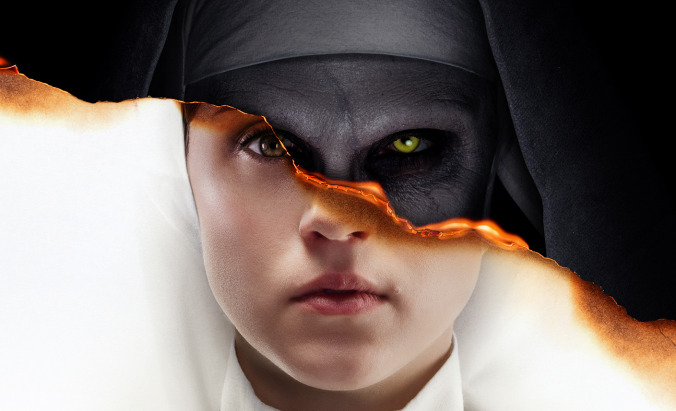It: Chapter One and Annabelle: Creation writer Gary Dauberman is credited with the screenplay, full of heavy-handed exposition and clumsy attempts at comic relief. Most of the latter come from the character of Frenchie (Jonas Bloquet), a French-Canadian farmer who ends up in Romania for reasons that seem inexplicable even to him. He’s a bit like one of those characters that grabs its creator’s pencil in a cartoon, vaguely aware that he exists within a prescribed narrative but not sure why or how. To the viewer, it’s obvious: He’s an in, an excuse to be speaking English in rural Romania and to have a sidekick at the ready with a shotgun and a wisecrack should tortured Father Burke (Demián Bichir) and naive Sister Irene (Taissa Farmiga) find themselves in real trouble.
The circumstances that lead Sister Irene and Father Burke to Frenchie’s door, and led both of them to the religious life in the first place, are similarly ill-defined. Although the characters do eventually exchange backgrounds and motivations in an exposition-heavy dialogue scene, what they provide isn’t much more satisfying than Burke’s initial, shrugging statement that the Vatican does things “for its own reasons.” What is clear is that the two have been sent to a remote abbey in a medieval castle to investigate the suicide of a young nun, which the Holy See fears is indicative of a larger problem. And boy, is it ever. In the film’s most (and perhaps only) satisfying narrative development, the abbey turns out to be humanity’s last line of defense against an ancient evil conjured by the castle’s original resident, a Vlad the Impaler-esque nobleman with a passion for black magic. Recently, the demon has begun to stir, awakened from centuries of slumber by the bombs of WWII.
Where the screenplay waters down the terror with comic asides, director Corin Hardy pumps it up with bloody, blasphemous, in-your-face horror imagery that’s as likely to produce stifled chortles as involuntary gasps. (Exhibit A: The crucifix that turns itself upside down and bursts into flames within the first five minutes.) This isn’t necessarily a bad thing: While some of Hardy’s aesthetic choices are cheesy enough for a carnival funhouse—the lighting is harsh and stagey throughout, and the music comically portentous—funhouses are, well, fun. And Hardy obliges with frequent jump scares, loud sound effects, and outrageous dolly zooms, using every tool in the modern horror toolbox to enhance the giddiness of scenes like the one early on in the film where Father Burke is lured into a cemetery (blanketed in fog, of course), then buried alive by an invisible adversary.
This glib rollercoaster approach does result in some skillfully executed scare scenes; the way Hardy films ghosts circling their human targets in particular, appearing and disappearing back into the shadows at will, is fiendishly slippery. But although the violence is the most graphic of all the movies in the franchise so far, there’s nothing in this film that’s nearly as suspenseful as the horror sequences in The Conjuring, or even in its sequel. (It doesn’t help that The Nun herself, with her glowing yellow eyes, becomes sillier the longer you look at her, and we get some nice long looks.) If you lose your breath during this movie, it’ll probably be from laughter. But if you adjust your expectations and go in expecting something loud, lurid, and frequently utterly ridiculous, it’s good for an adrenaline rush all the same.

